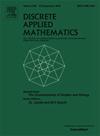About the infinite windy firebreak location problem
IF 1
3区 数学
Q3 MATHEMATICS, APPLIED
引用次数: 0
Abstract
The severity of wildfires can be mitigated using preventive measures like the construction of firebreaks, which are strips of land from which the vegetation is completely removed. In this paper, we model the problem of wildfire containment as an optimization problem on infinite graphs called Infinite Windy Firebreak Location. A land of unknown size is modeled as an infinite undirected graph in which the vertices correspond to areas subject to fire and edges represent fire propagation from one area to another. A firebreak construction is modeled as removing the edge between two vertices. The number of firebreaks that can be installed depends on budget constraints. We assume that a fire ignites in a subset of vertices and propagates to the neighbors. The goal is to select a subset of edges to remove in order to contain the fire and avoid burning an infinite part of the graph. We prove that Infinite Windy Firebreak Location is coNP-complete in restricted cases, and we address some polynomial cases. We show that Infinite Windy Firebreak Location polynomially reduces to Min Cut for certain classes of graphs like infinite grid graphs and polyomino-grids.
关于无限风防火墙的选址问题
野火的严重程度可以通过建造防火带等预防措施来减轻,防火带是指将植被完全清除的带状土地。在本文中,我们将野火控制问题建模为无限图上的优化问题,称为无限风阻火线位置。未知大小的土地被建模为无限无向图,其中顶点对应于受火的区域,边缘表示火从一个区域传播到另一个区域。防火墙的构造被建模为移除两个顶点之间的边缘。可以安装的防火墙数量取决于预算限制。我们假设火灾在一个顶点子集中点燃,并传播到相邻的顶点。目标是选择一个边缘子集来移除,以控制火焰并避免烧毁图的无限部分。在有限情况下,证明了无限多风防火位置是conp完全的,并讨论了一些多项式情况。我们证明了对于无限网格图和多边形网格等特定类型的图,无限风火线位置多项式地约简到最小切。
本文章由计算机程序翻译,如有差异,请以英文原文为准。
求助全文
约1分钟内获得全文
求助全文
来源期刊

Discrete Applied Mathematics
数学-应用数学
CiteScore
2.30
自引率
9.10%
发文量
422
审稿时长
4.5 months
期刊介绍:
The aim of Discrete Applied Mathematics is to bring together research papers in different areas of algorithmic and applicable discrete mathematics as well as applications of combinatorial mathematics to informatics and various areas of science and technology. Contributions presented to the journal can be research papers, short notes, surveys, and possibly research problems. The "Communications" section will be devoted to the fastest possible publication of recent research results that are checked and recommended for publication by a member of the Editorial Board. The journal will also publish a limited number of book announcements as well as proceedings of conferences. These proceedings will be fully refereed and adhere to the normal standards of the journal.
Potential authors are advised to view the journal and the open calls-for-papers of special issues before submitting their manuscripts. Only high-quality, original work that is within the scope of the journal or the targeted special issue will be considered.
 求助内容:
求助内容: 应助结果提醒方式:
应助结果提醒方式:


